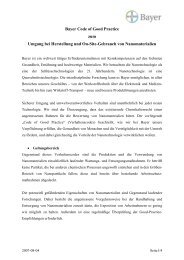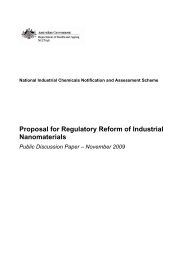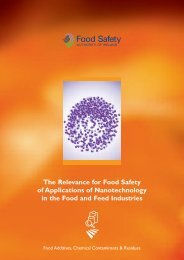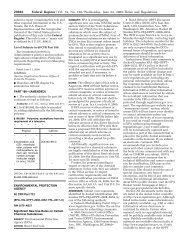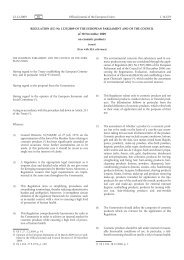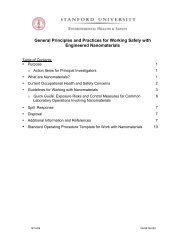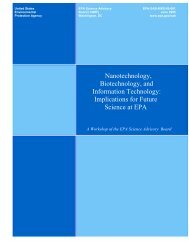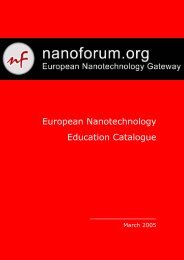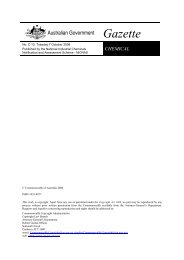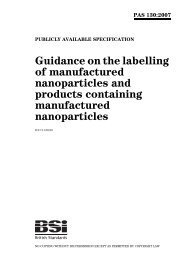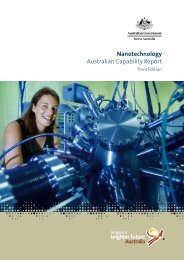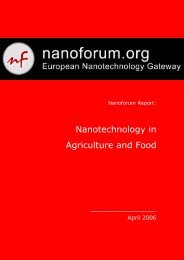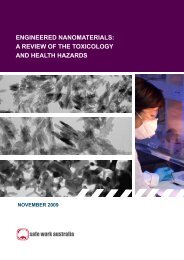Nanoforum - Nanotech Regulatory Document Archive
Nanoforum - Nanotech Regulatory Document Archive
Nanoforum - Nanotech Regulatory Document Archive
You also want an ePaper? Increase the reach of your titles
YUMPU automatically turns print PDFs into web optimized ePapers that Google loves.
13.2. National programmes and projects<br />
The Slovak Academy of Sciences (SAS) is Slovakia’s foremost institution for the<br />
promotion and support of basic, strategic and applied research. The Academy’s<br />
primary mission is the advance of knowledge and understanding of the nature and social<br />
sciences. In fact, the Academy provides support to the demands of the scientific<br />
community in Slovakia.<br />
Since the scientific community in Slovakia only represents a small fraction of the<br />
world community, scientific endeavours of the SAS are undertaken in close<br />
collaboration with current scientific activities abroad. The SAS principally supports<br />
those scientific and scholarly disciplines which attain international levels and which<br />
are deemed necessary for the advancement of Slovakia and its international<br />
aspiration.<br />
There are results of this support. The SAS has concluded co-operative contracts<br />
with partner institutions abroad supported by 53 inter-academic agreements. The<br />
SAS also has recently installed the NANOSMART Centre of Excellence in<br />
Nanomaterials. Around 60 researchers, from the SAS institutes on Materials Research,<br />
Inorganic Chemistry, Experimental Physics, Geotechnics, Materials and Machine<br />
Mechanics, Physics, and Electrical Engineering, collaborate in it. Research topics are<br />
mainly dedicated to ceramic nanocomposites and metallic materials, and<br />
mechanical, magnetic, superconducting, semiconducting, electric properties and<br />
water treatment.<br />
The main activities on nano are the following:<br />
• Multifunctional ceramic nanocomposites based on Si3 N4 powders exhibiting a<br />
self-diagnostics of defects and improved properties at room and higher<br />
temperatures.<br />
• Nanostructural materials for construction applications having ultrahigh<br />
strength combined with a lightweight (aluminium alloys), excellent thermal<br />
conductivity (copper alloys), or biocompatibility (titanium alloys).<br />
• Unique magnetic nanomaterials based on Fe, Ni, Co with magnetic<br />
nanoparticles in metallic or insulating matrix, exhibiting very low<br />
coercivity, high saturation magnetisation, low losses, high magnetoresistance,<br />
as well as self-assembled media for magnetic data recording,<br />
materials for sensoring, etc.<br />
• Superconducting nanomaterials (e.g. Y2 BaCuO3 nanoparticles embedded in<br />
Yba2 Cu3 O7 single crystals, or Nb, NbN nanoparticles embedded in metallic<br />
matrix).<br />
• Non-magnetic semiconducting nanoparticles in insulating matrix showing<br />
electron Confinement.<br />
• Model metallic (Cu, Pb, Gd, Dy) and ferritic nanoparticles, and sulfitic<br />
nanoparticles used for absorption of toxic metals from wastewater.<br />
197



